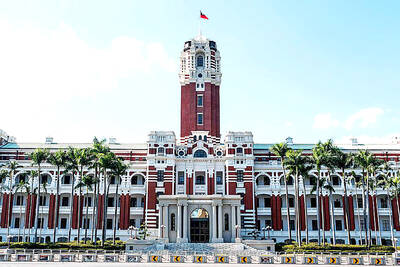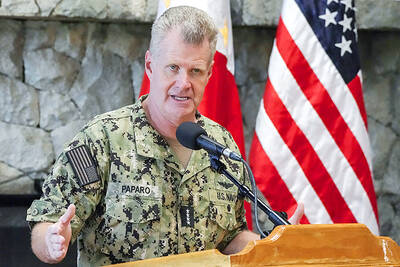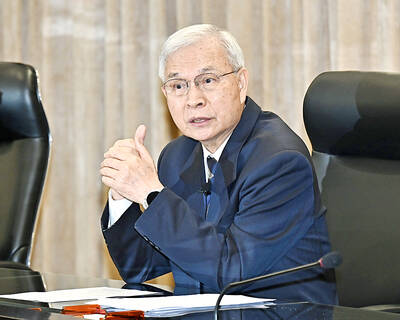China has based its new anti-ship Dong Feng-21D (DF-21D) “carrier killer” missiles along the coast facing Taiwan, US Defense Intelligence Agency Director Michael Flynn said in testimony before the US Senate Armed Services Committee.
Flynn said that Beijing was enhancing the firepower of the more than 1,200 conventional short-range ballistic missiles deployed opposite Taiwan with a limited, but growing, number of conventionally armed, medium-range ballistic missiles, including the DF-21D.
“China is developing a tiered ballistic missile defense system and has successfully tested the upper-tier capability on two occasions,” he said.
Flynn said that China’s People’s Liberation Army (PLA) was building a modern military capable of defending China’s “core interests” of protecting territorial integrity, including Taiwan.
“Preparation for a Taiwan conflict with US intervention remains the primary driver of the PLA’s evolving force structure, weapons development, operational planning and training,” Flynn said, adding that “China has spent as much as US$215 billion on military-related goods and services in 2012, in contrast to the US$107 billion Beijing reported in its official military budget.”
“Even as the Chinese military plans for conflict and continues its build-up across from Taiwan, cross-strait relations have remained good following President Ma Ying-jeou’s (馬英九) re-election,” he added.
Flynn said the PLA Navy was also developing a JIN-class nuclear-powered ballistic missile submarine and JL-2 submarine-launched missiles.
He said that China’s investment in naval weapons is focused primarily on anti-air and anti-surface capabilities to achieve periodic and local sea and air superiority.
Flynn said that the Chinese air force was transforming from a force oriented solely toward territorial defense into one capable of both offshore offensive and defensive roles, including strike, air and missile defense, as well as early warning and reconnaissance.
While Flynn did not say why China had deployed the new “carrier-killer” missiles opposite Taiwan, Pentagon sources said it was a clear warning to the US to stay well clear of the area in case of a conflict.
However, a report published earlier this month by Ronald O’Rourke, the Congressional Research Service’s specialist in naval affairs, said the missile could be defeated with a combination of active and passive measures along its “kill chain.”
O’Rourke said the US Navy could reduce the aircraft carrier electromagnetic emissions used by the missile and even release false emissions to fool it. In addition, the US Navy could disable the missile’s targeting systems, destroy it in flight or use decoys to confuse it as it approached its target, he added.

The CIA has a message for Chinese government officials worried about their place in Chinese President Xi Jinping’s (習近平) government: Come work with us. The agency released two Mandarin-language videos on social media on Thursday inviting disgruntled officials to contact the CIA. The recruitment videos posted on YouTube and X racked up more than 5 million views combined in their first day. The outreach comes as CIA Director John Ratcliffe has vowed to boost the agency’s use of intelligence from human sources and its focus on China, which has recently targeted US officials with its own espionage operations. The videos are “aimed at

STEADFAST FRIEND: The bills encourage increased Taiwan-US engagement and address China’s distortion of UN Resolution 2758 to isolate Taiwan internationally The Presidential Office yesterday thanked the US House of Representatives for unanimously passing two Taiwan-related bills highlighting its solid support for Taiwan’s democracy and global participation, and for deepening bilateral relations. One of the bills, the Taiwan Assurance Implementation Act, requires the US Department of State to periodically review its guidelines for engagement with Taiwan, and report to the US Congress on the guidelines and plans to lift self-imposed limitations on US-Taiwan engagement. The other bill is the Taiwan International Solidarity Act, which clarifies that UN Resolution 2758 does not address the issue of the representation of Taiwan or its people in

US Indo-Pacific Commander Admiral Samuel Paparo on Friday expressed concern over the rate at which China is diversifying its military exercises, the Financial Times (FT) reported on Saturday. “The rates of change on the depth and breadth of their exercises is the one non-linear effect that I’ve seen in the last year that wakes me up at night or keeps me up at night,” Paparo was quoted by FT as saying while attending the annual Sedona Forum at the McCain Institute in Arizona. Paparo also expressed concern over the speed with which China was expanding its military. While the US

SHIFT: Taiwan’s better-than-expected first-quarter GDP and signs of weakness in the US have driven global capital back to emerging markets, the central bank head said The central bank yesterday blamed market speculation for the steep rise in the local currency, and urged exporters and financial institutions to stay calm and stop panic sell-offs to avoid hurting their own profitability. The nation’s top monetary policymaker said that it would step in, if necessary, to maintain order and stability in the foreign exchange market. The remarks came as the NT dollar yesterday closed up NT$0.919 to NT$30.145 against the US dollar in Taipei trading, after rising as high as NT$29.59 in intraday trading. The local currency has surged 5.85 percent against the greenback over the past two sessions, central